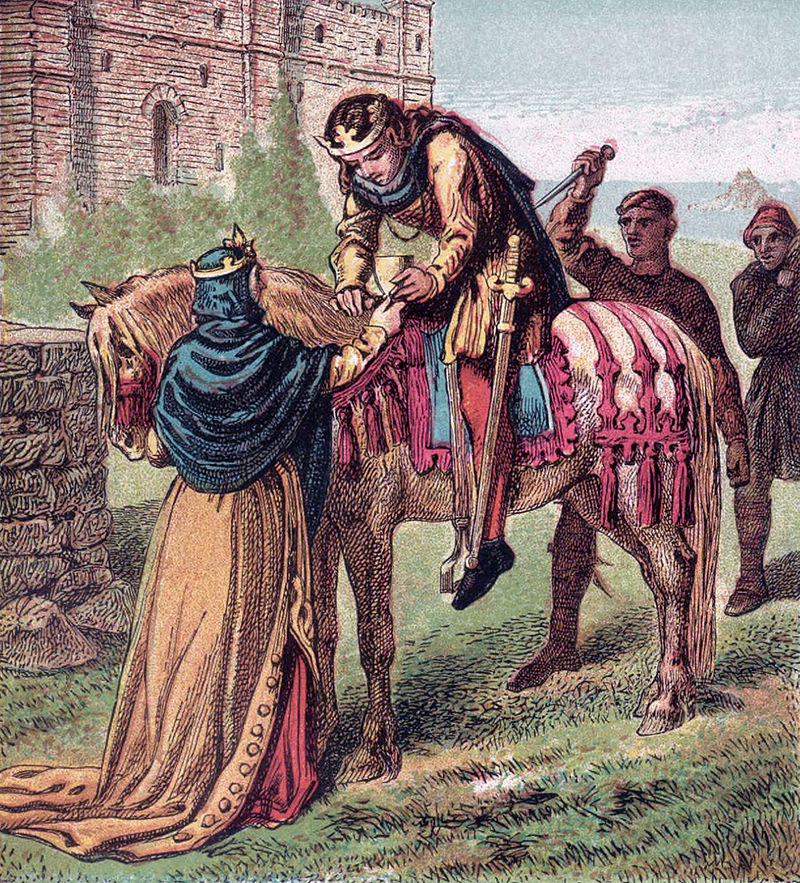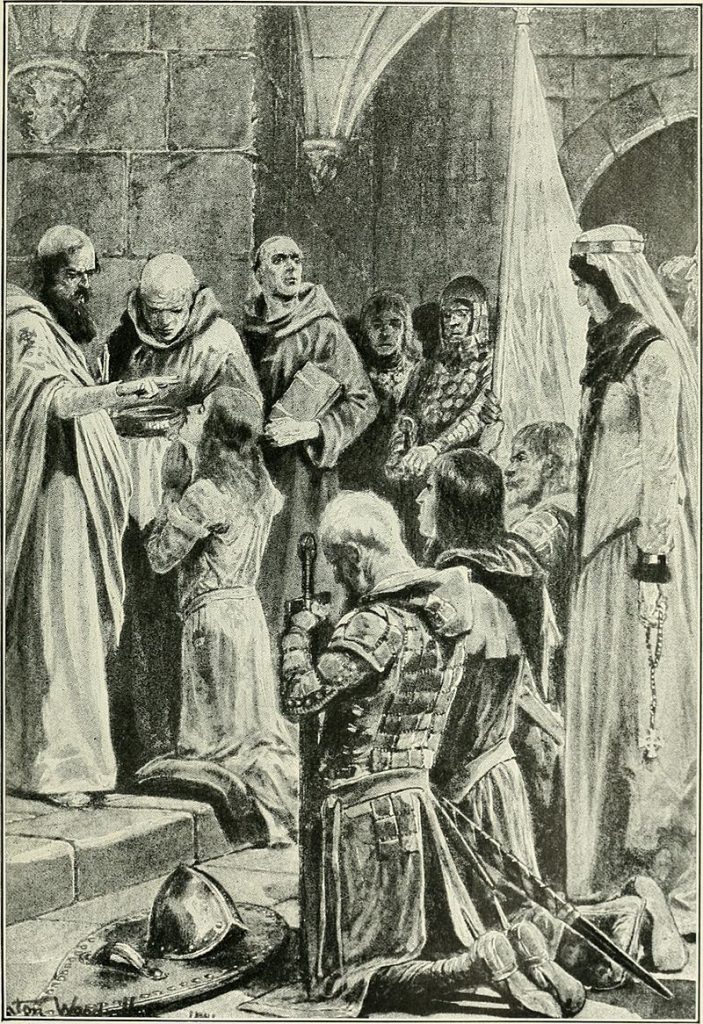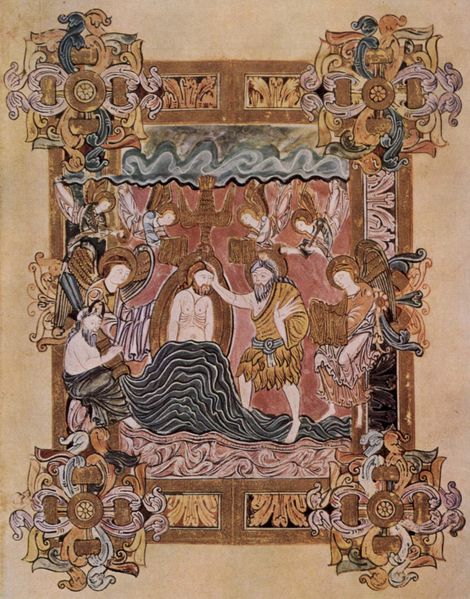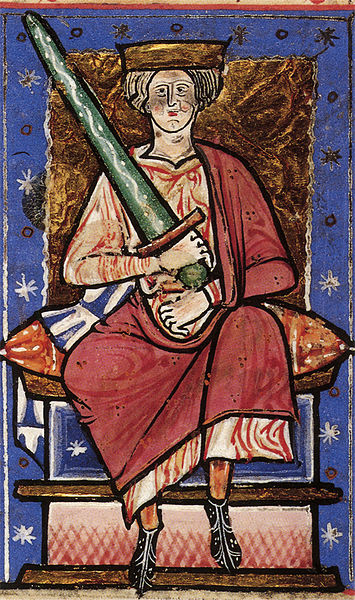
King Æthelred II, from The Life of King Edward the Confssor. 13th c. Cambridge University Library
On 23 April 1016, Æthelred, king of England, died in London. He was about 50 years old, and he’d ruled England for 38 years. At his death he’d not yet been given the byname, Unræd, (ill-counseled, a play on the Old English meaning of his name, æthel ræd – noble counsel). That would come some years later. Eventually Unræd would be corrupted into Unready, and he would be known as Æthelred the Unready for centuries. As the bynames suggest, his reputation has been anything but enviable:
“His life is said to have been cruel at the outset, pitiable in mid-course, and disgraceful in its ending.” William of Malmesbury, History of the English Kings, 12th century;
“He is the only ruler of the male line of Ecbert whom we can unhesitatingly set down as a bad man and a bad king.” Edward Freeman, The History of the Norman Conquest of England, 1867.
According to historian Simon Keynes’ entry in the Oxford Dictionary of National Biography he was “unequal to the challenge that confronted him, and unfortunate in the circumstances that engulfed him…”
But what do we really know about the man himself?
Biographer Ann Williams, in Æthelred the Unready, the Ill-counselled King, cautions: “We do not and cannot know what kind of a man Æthelred was, only what he did and what happened to him.”
Nevertheless, the things that Æthelred did would seem to indicate that he could be in turns ruthless or diplomatic, vindictive or forgiving, energetic or irresolute. One historian refers to his reign as bi-polar. Even the Anglo-Saxon Chronicle entries for this period are as puzzling as they are gripping (and depressing).
Æthelred took the throne under a cloud of suspicion and foreboding. His half-brother, King Edward, had been attacked and murdered, and that crime paved the way for Æthelred’s coronation.

As the queen greets her stepson, his murderers creep up behind him. Wikimedia Commons
That no one was punished for King Edward’s murder hints at a cover-up, if not collusion, by someone in power; if not the young Æthelred, aged ten, then others quite close to him–perhaps even standing right behind him as he was anointed king.

Coronation of the young AEthelred, watched over by his mother, the queen. From a 19th century popular history. Wikimedia Commons
William of Malmesbury wrote that Æthelred was “haunted by the shade of his brother, demanding terribly the price of blood.” He seems to imply that the troubles that Æthelred faced were brought on by that unpunished murder of King Edward, and that the English suffered because of it. But what happened over the next 30-odd years was far more complicated than that.
When Æthelred attained the throne, England had been a united kingdom for a mere forty years, and allegiances to kin were still far stronger than any oaths made to a distant king. The murder of Æthelred’s half-brother King Edward by men who had sworn loyalty to him is a sign of unrest that didn’t end with the new king’s coronation. When he came of age, Æthelred resorted to steel-gloved efforts to rein in his nobles. These included confiscation of property, exile, blinding, execution, and outright murder.
It wasn’t easy being king.
Æthelred’s sullied reputation rests mostly, though, on his failure to protect his people from the ravages of the northmen. According to the Anglo-Saxon Chronicle, of the 38 years of his monarchy, only 14 were free from devastation inflicted by ever larger viking armies. Æthelred’s efforts to protect England failed utterly. The armies he raised were vanquished. His attempts to bribe the vikings bought England only brief respites. His alliance with Normandy in 1002 brought him a new queen who gave him three children to add to his tally of six sons and 4 daughters by his first wife, but it did not rid him of his ship-borne enemies, one of whom would drive him from his kingdom. Only Swein Forkbeard’s sudden death would allow Æthelred to re-take his throne.

Swein Forkbeard, who conquered AEthelred’s England in 1013. Photo: Nigel Davies / Viking detail in Swansea Guildhall. Wikimedia Commons
Was Æthelred any more ruthless or cruel than other rulers of his time? Probably not. His was a world that was governed by the sword despite the laws that he enacted and presumably sought to enforce. In the final, dark years of his reign, with a Viking army ravaging the land, all loyalties were strained to the breaking point, and English unity was fractured more than ever. “…there was not a chief that would collect an army, but each fled as he could: no shire, moreover, would stand by another.” (The Anglo-Saxon Chronicle)
Nevertheless, Æthelred’s success at holding his kingdom together for nearly 40 years–except for his 4-month exile in Normandy–meant that art and culture could flourish despite the unrest that plagued the land. Benedictine abbeys patronized by wealthy nobles produced metalwork, sculptures, and gloriously illuminated manuscripts.

The Benedictional of St. Aethelwold. Winchester. 10th c. British Library (Wikimedia Commons)
Many of the greatest works of Old English literature were written at this time including lives of saints and the homilies of Ælfric and of scholar/statesman Archbishop Wulfstan. The only copy of Beowulf in existence was produced, it’s believed, while Æthelred was king.
Such accomplishments as these, though, must be weighed against murders, executions, misplaced trust, bad decisions and desperation that characterized his reign. Æthelred died a reinstated king, but he was a king who had been ill-equipped to cope with the enormous challenges he faced. Even if he was not literally haunted by his brother’s ghost, he must have been, in his final days, haunted by his failures as a ruler.
“He ended his days on St. George’s day; having held his kingdom in much tribulation and difficulty as long as his life continued.” The Anglo-Saxon Chronicle, 11th century

Wikimedia Commons
The traditional tale of his accession cast his mother Ælfþryð as the wicked stepmother behind Edward’s murder. But I seem to recall that in Iceland ‘Aðalráðr’ was not described in the contemptuous terms that one might have expected.
Hello, and thank you for your comment. Yes, the blame for Edward’s death fell on his stepmother Aelfthryth, and she was accused, in later years, of all sorts of sins. This frequently happened to the reputation of high status women, and AElfthryth’s reputation, in recent years, has been reassessed and somewhat resurrected by a number of studies. My own belief is that, at least where Edward’s murder was concerned, there must have been some culpability on her part. She was part of a faction at court that strenuously opposed Edward’s regime. Her involvement in his death may have been simply turning a blind eye to what was going on around her, or it may have been an inadvertent, offhand remark (will no one rid me of this turbulent kid?). While I don’t think she was the evil stepmother that she’s been painted, I don’t think she was completely innocent. As for AEthelred, as a novelist I’ve used him as a villain, and because of that I’ve had to paint him as darker than he probably was.